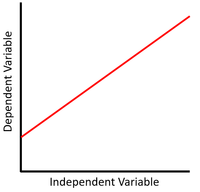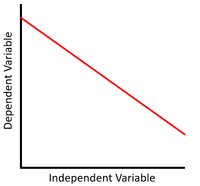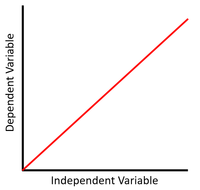Difference between revisions of "Linear Graph"
(→About Proportional Graphs) |
|||
| Line 3: | Line 3: | ||
When a relationship between two [[variable]]s is '''linear''' they increase by a constant amount in relation to one another. | When a relationship between two [[variable]]s is '''linear''' they increase by a constant amount in relation to one another. | ||
| − | ===About | + | ===About Linear Relationships=== |
: A [[Scatter Graph|scatter graph]] showing a '''linear''' relationship has straight [[Line of Best Fit|line of best fit]]. | : A [[Scatter Graph|scatter graph]] showing a '''linear''' relationship has straight [[Line of Best Fit|line of best fit]]. | ||
: On a '''linear graph'''; when one [[variable]] increases, the other increase or when one increases the other decreases. | : On a '''linear graph'''; when one [[variable]] increases, the other increase or when one increases the other decreases. | ||
: A '''linear relationship''' may have a non-zero [[y-intercept]]. | : A '''linear relationship''' may have a non-zero [[y-intercept]]. | ||
: If the [[Line of Best Fit|line of best fit]] on for a '''linear relationship''' has a [[y-intercept]] of zero then it is called '[[Directly Proportional|directly '''proportional''']]'. | : If the [[Line of Best Fit|line of best fit]] on for a '''linear relationship''' has a [[y-intercept]] of zero then it is called '[[Directly Proportional|directly '''proportional''']]'. | ||
| + | |||
===Examples=== | ===Examples=== | ||
{| class="wikitable" | {| class="wikitable" | ||
Latest revision as of 15:30, 5 December 2021
Key Stage 4
Meaning
When a relationship between two variables is linear they increase by a constant amount in relation to one another.
About Linear Relationships
- A scatter graph showing a linear relationship has straight line of best fit.
- On a linear graph; when one variable increases, the other increase or when one increases the other decreases.
- A linear relationship may have a non-zero y-intercept.
- If the line of best fit on for a linear relationship has a y-intercept of zero then it is called 'directly proportional'.
Examples
| This scatter graph shows a linear relationship where x increases and y increases.
\(y = mx + c\) Where m, the gradient, is positive. |
This scatter graph shows a linear relationship where x increases and y decreases.
\(y = mx + c\) Where m, the gradient, is negative. |
This scatter graph shows a linear relationship that is directly proportional where x doubles, y doubles.
\(y = mx\) Where m, the gradient, is positive. |


